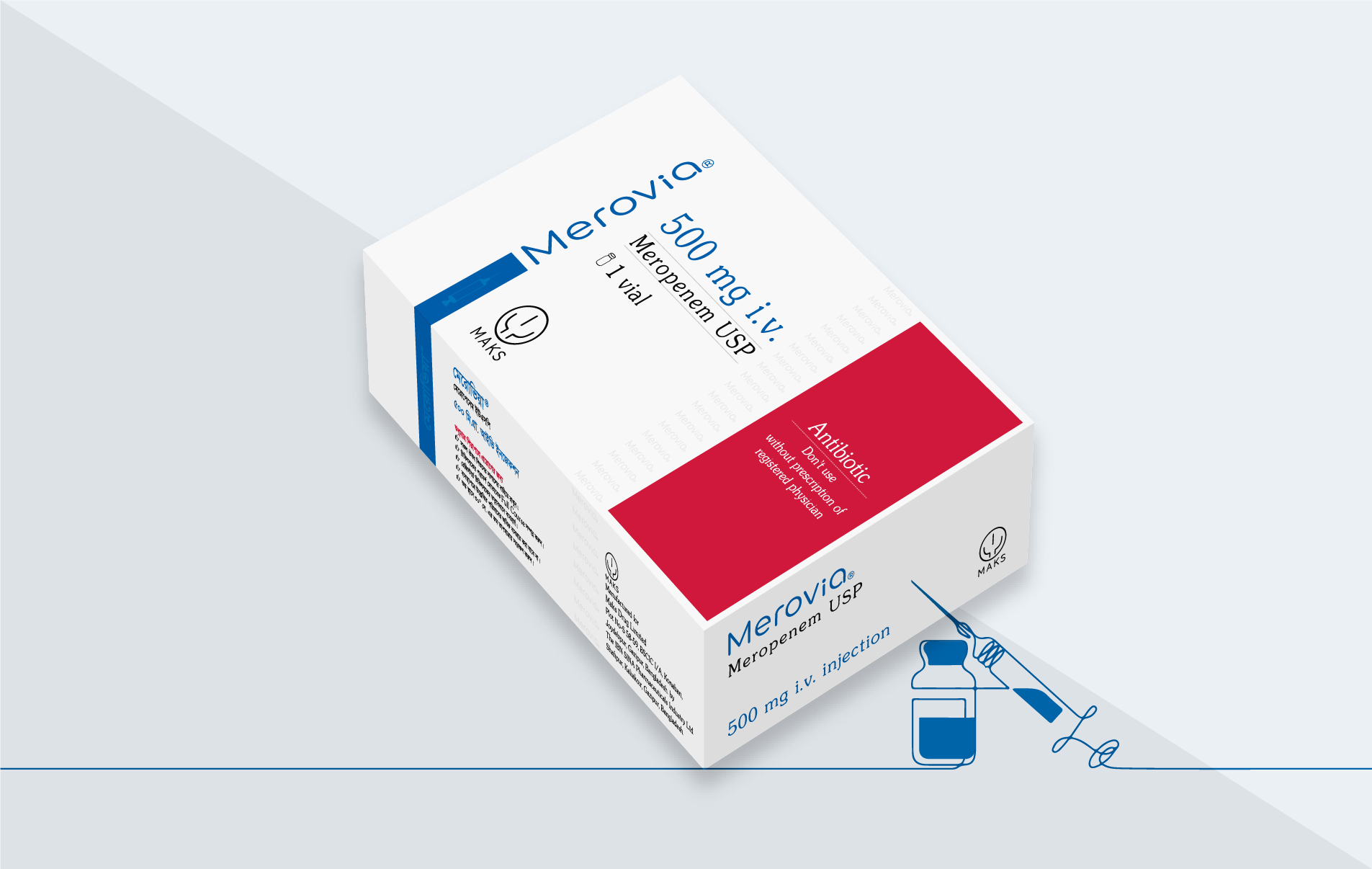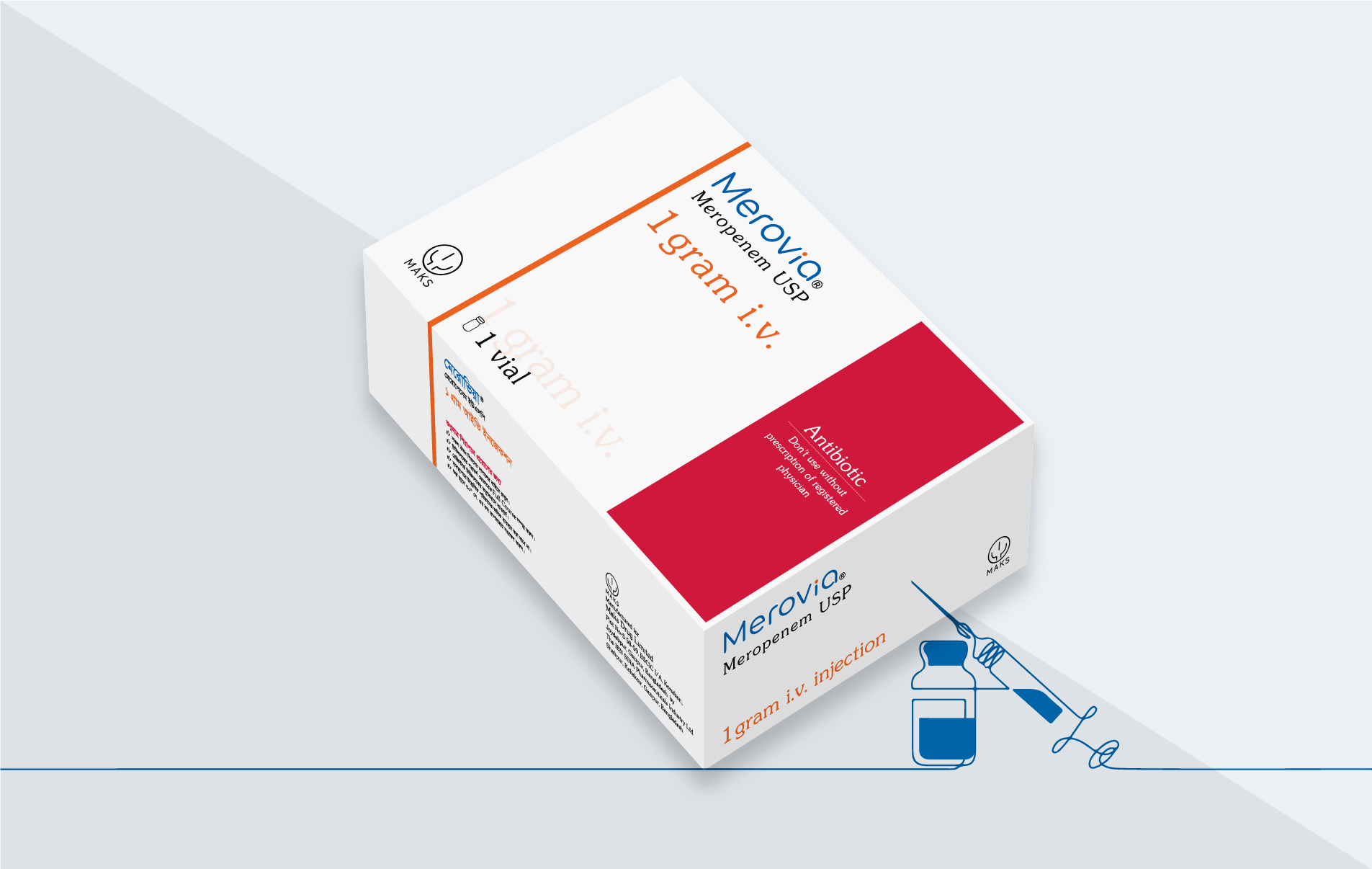Merovia (Meropenem)
Therapeutic Group: Antibiotics
Merovia® 500 mg IV injection: Each vial contains Meropenem USP 500 mg as Meropenem Sodium Carbonate.
Merovia® 1 gram
IV injection: Each vial contains Meropenem USP 1 gram as Meropenem Sodium
Carbonate.
Meropenem is a
carbapenem antibiotic for parenteral use, that is stable to human
dehydropeptidase-I (DHP-I). It is structurally similar to imipenem. Meropenem
exerts its bactericidal action by interfering with vital bacterial cell wall
synthesis. The ease with which it penetrates bacterial cells, its high level of
stability to all serine b-lactamases and its marked affinity for the Penicillin
Binding Proteins (PBPs) explain the potent bactericidal activity of Meropenem
against a broad spectrum of aerobic and anaerobic bacteria. Meropenem is stable
in susceptibility tests and these tests can be performed using the normal
routine systems. In vitro tests show that Meropenem can act synergistically
with various antibiotics. It has been demonstrated both in vitro and in vivo
that Meropenem has a post-antibiotic effect against Gram-positive and
Gram-negative organisms.
The in vitro
antibacterial spectrum of Meropenem includes the majority of clinically
significant Gram-positive and Gram-negative, aerobic and anaerobic strains of
bacteria.
Merovia® is
indicated for treatment, in adults and children, of the following infections
caused by single or multiple susceptible bacteria and as empiric therapy prior
to the identification of the causative organisms:
• Lower Respiratory Tract Infections
• Urinary Tract Infections,
including complicated infections
• Intra-abdominal Infections
• Gynaecological Infections,
including postpartum infections
• Skin and Skin Structure Infections
• Meningitis
• Septicaemia
• Empiric treatment, including initital monotherapy, for presumed
bacterial infections in host-compromised, neutropenic patient
Because of its
broad spectrum of bactericidal activity against Gram-positive and Gram-negative
aerobic and anaerobic bacteria, Merovia® is effective for the treatment of
polymicrobial infections.
Adults
Usual dose
500 mg to 1 gram by intravenous administration every 8 hours depending on type and severity of infection, the known or expected susceptibility of the pathogen(s) and the condition of the patient.
Exceptions
1. Febrile
episodes in neutropenic patients - the dose should be 1 gram every 8 hours.
2. Meningitis -
the dose should be 2 gram every 8 hours.
As with other
antibiotics, caution may be required in using Meropenem as monotherapy in
critically ill patients with known or suspected Pseudomonas aeruginosa lower
respiratory tract infections. Regular sensitivity testing is recommended when
treating Pseudomonas aeruginosa infections. Merovia® should be given as an
intravenous bolus injection over approximately 5 minutes or by intravenous
infusion over approximately 15 to 30 minutes (see Method of Administration).
Elderly
No dosage
adjustment is required for the elderly with normal renal function or creatinine
clearance values above 50 ml/min.
Children
For infants and
children over 3 months and up to 12 years of age the recommended intravenous
dose is 10 to 40 mg/kg every 8 hours depending on type and severity of
infection, the known or suspected susceptibility of the pathogen(s) and the
condition of the patient. In children over 50 kg weight, adult dosage should be
used.
Exceptions
1. Febrile
episodes in neutropenic patients - the dose should be 20 mg/kg every 8 hours.
2. Meningitis -
the dose should be 40 mg/kg every 8 hours.
Pediatric
patients less than 3 months of age with complicated intra-abdominal infections,
the dose is based on gestational age (GA) and postnatal age (PNA) & should
be given as intravenous infusion over 30 minutes. Merovia® should be given as
an IV bolus over approximately 5 minutes or by intravenous infusion over
approximately 15 to 30 minutes. There is no experience in children with renal
impairment.
Merovia® is
generally well tolerated. Adverse events rarely lead to cessation of treatment.
Serious adverse events are rare thrombocythaemia, nausea, vomiting, diarrhea,
increases in serum transaminases, bilirubin, alkaline phosphatase, lactic
dehydrogenase, inflammation, thrombophlebitis, pain, eosinophilia,
thrombocytopenia, headache, paresthesiae, rash, urticaria, pruritis,
leucopenia, neutropenia, agranulocytosis, convulsions, oral and vaginal
candidiasis, haemolytic anaemia, angioedema, manifestations of anaphylaxis,
pseudomembranous colitis, erythema multiforme, stevens-Johnson syndrome, toxic
epidermal necrolysis.
Patients who have a history of hypersensitivity to carbapenems, penicillins or other beta-lactam antibiotics may also be hypersensitive to Merovia®. As with all beta-lactam antibiotics rare hypersensitivity reactions have been reported.
Rarely, pseudomembranous colitis has been reported with Merovia® as with virtually all antibiotics; therefore, its diagnosis should be considered in patients who develop diarrhoea in association with the use of Merovia®.
Merovia® may
reduce serum valproic acid levels. Subtherapeutic levels may be reached in some
patients.
Probenecid competes with meropenem for active tubular secretion and thus inhibits the renal excretion of meropenem with the effect of increasing the elimination half-life and plasma concentration of meropenem. As the potency and duration of action of Merovia® dosed without probenecid are adequate the co-administration of probenecid with Merovia® is not recommended. The potential effect of Merovia® on the protein binding of other medicines or metabolism has not been studied. However, the protein binding is so low (approximately 2%) that no interactions with other compounds would be expected on the basis of this mechanism. Merovia® has been administered concomitantly with many other medications without apparent adverse interaction. Merovia® may reduce serum valproic acid levels. Subtherapeutic levels may be reached in some patients. However, no specific drug interaction studies other than with probenecid were conducted.
Intentional
overdosing of Merovia® is unlikely, although overdosing could occur during
therapy particularly in patients with renal impairment. Limited post-marketing
experience indicates that if adverse events occur following overdosage, they
are consistent with the adverse event profile described in Adverse effects, are
generally mild in severity and resolve on withdrawal or dose reduction.
Symptomatic treatments should be considered. In normal individuals rapid renal
elimination will occur. Haemodialysis will remove Merovia® and its metabolite.
Prior to
constitution, store Merovia® powder for intravenous injection or infusion packs
below 30° C. To reduce microbiological hazard, solutions of Merovia® IV should
be used as soon as practicable after reconstitution. The freshly reconstituted
solution is recommended. Its efficacy is maintained for at least 2 hours at
room temperature or 12 hours in the refrigerator at 2-8° C. Solutions of
Merovia® should not be frozen.
Merovia® 500 mg
IV Injection: Each combipack contains 1 vial of Meropenem USP 500 mg as
Meropenem Sodium Carbonate and 1 ampoule of 10 ml WFI. It also contains a complementary pouch comprised of sterile
disposable syringe (10 ml), 1 scalp vein set, 1 alcohol pad and 1 first aid
bandage.
Merovia® 1 gram
IV Injection: Each combipack contains 1 vial of Meropenem USP 1 gram as
Meropenem Sodium Carbonate and 2 ampoule of 10 ml WFI. It also contains a
complementary pouch comprised of sterile disposable syringe (20 ml), 1 scalp
vein set, 1 alcohol pad and 1 first aid bandage.



